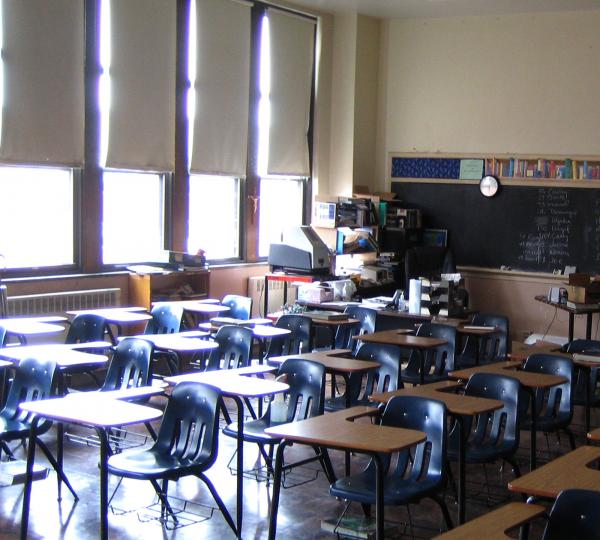Has Your Child’s School Adopted the Precautionary Principle?

Children in our day suffer from a host of diseases and problems that our great-grandparents could not have imagined.
We have seen increases over the span of one generation in autism, learning disabilities, certain birth defects and cancers, asthma, obesity, and diabetes. The nature of the increases point to the possibility that these afflictions may have been preventable. Some statistics are startling: the chance that a little girl would get breast cancer was only one in 25 when my mother got married. But now, one woman in seven can expect to get breast cancer. By the time my 12-year-old niece gets married, one in three will likely face that diagnosis. Unless we do something.
My generation came of age in a world in which the best minds thought we could measure and manage risk. We believed that economic decisions would take care of any unacceptable risk and the market would make necessary course corrections. That old approach has failed. Measuring and managing risk has led to global warming, emptying the oceans of fish, polluting much of the world with toxic chemicals, and increasing chronic diseases in humans. The GNP may be healthy, but our world and our children are not.
Risk management may represent a flawed strategy, but a new and significant approach to protecting public health has emerged in the last decade. In January of 1998, at the Johnson Foundation's Wingspread Conference Center, environmental leaders met to develop guiding principles for evaluating decisions that affect human health and the environment. They came to consensus around what is referred to as the precautionary principle, or the "forecaring" principle. It is based on the simple notion that an ounce of prevention is worth a pound of cure.
The group called on governments, corporations, communities, and scientists to implement the precautionary principle when making decisions affecting public health:
When an activity raises threats of harm to the environment or human health, precautionary measures should be taken even if some cause and effect relationships are not fully established scientifically. In this context the proponent of an activity, rather than the public, should bear the burden of proof. The process of applying the precautionary principle must be open, informed, and democratic, and must include potentially affected parties. It must also involve an examination of the full range of alternatives, including no action.
In other words, we can take precautionary action in order to prevent harm and suffering in the face of uncertainty. This simple idea of preventing harm is, at its core, an ethical precept, with its origins in other ethical norms like the physician's Hippocratic Oath to do no harm or the Golden Rule, which says we should do to others as we would have them do to us. In this case, "others" represents our fellow beings on the Earth, including future generations. Implementing the precautionary principle emphasizes upstream evaluation and decision-making—preventing potential problems and harm—in contrast to the risk management approach based on evaluating our capacity to deal with problems downstream.
While several state, municipal and county governments have adopted the precautionary principle to guide environmental and public health policy, public schools have been in the vanguard of this precautionary principle movement. The school is a primary environment for children from the day they enter kindergarten until the day they walk out with a diploma. In the late 1990's the Los Angeles Unified School District adopted the precautionary principle paired with a program of Integrated Pest Management to eliminate unnecessary pesticides from the buildings and grounds of the largest school district in the United States. LAUSD chose this route because they believed that a child's future health and learning potential should not be compromised through the use of pesticides that include neurotoxicants, carcinogens, or mutagens on playgrounds or in classrooms.
More recently the Governing Authority of the Emeryville Unified School District in California adopted the precautionary principle as the foundation of all its environmental policy. This far-reaching policy will guide everything from curriculum to building materials and the food served at the schools. Some elements of the precautionary principle included in the policy are the following:
- The community has a right to complete and accurate information on the impacts of school district choices. The proponent of the product or service must supply the information, not the public.
- Precautionary decisions should be transparent, participatory and democratic.
- The district asserts an obligation to examine and choose the alternative with the least harmful impact on human health and the environment.
- When evaluating those alternatives, there is a duty to consider all the reasonably foreseeable costs, including raw materials, manufacturing, transportation, use, cleanup, eventual disposal and health costs even if such costs are not reflected in the initial price. Short- and long–term benefits and time thresholds should be considered when making decisions.
Taking the long view is key to the precautionary principle. Our children stand on the threshold of the future. My Indigenous friends say that the precautionary principle is the seventh generation principle, which comes from the Six Nations Iroquois Confederacy practice of making decisions with the seventh generation in mind. The only way we can guarantee that we leave blessings and an inheritance for future generations, rather than the fruits of our shortsightedness, is to acknowledge that we can't wait for science to prove everything before we take action. We need to use the precautionary principle and make decisions that are the wisest, fairest, and most preventive of harm.
In adopting the precautionary principle, members of the Emeryville School District school board chose to assume the role of guardians of this generation and those to come. As guardians they are taking steps to protect children for the long term. Those steps were laid out in 10 action points, three of which describe a precautionary food policy. The food recommendations are to:
Follow and build upon the examples of New York City, Chicago, Nashville, San Francisco and others and ban soda, candy, junk food, and fast food from all school grounds.
Evaluate the district's school lunch program to ensure good nutrition and consider developing a farm–to–school program.
Encourage the development of school gardens and green schoolyards as hands–on learning tools that promote good nutrition and stewardship of the land.
The Emeryville School District leaders intuitively understand that school meal programs stand at the center of our hope for a good and healthy future. Lunch is the time when we can say, "We have provided food that will nurture your body and not harm you. We want to show you your place in the community of farmers, bees, water, and the land that grew your food. We promise to be wise guardians of your future."
School lunch is our communion, of past lessons and hope for the future, of knowledge that wisdom accrues in small bites, and of our vow to forecare.




